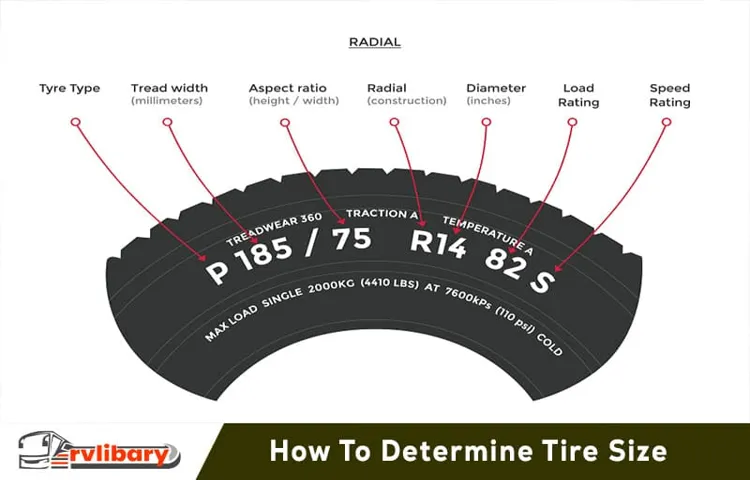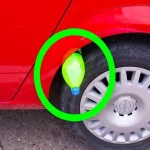Have you ever felt unsure about the correct tire pressure for your aftermarket tires? It can be a daunting task considering the varying sizes and weights of the tires on the market. However, knowing the proper tire pressure is crucial not only for safety but also for maximizing performance and lifespan of your tires. In this blog, we will dive into the importance of determining the correct tire pressure for your aftermarket tires and provide you with tips on how to easily obtain this information.
Think of this guide as your personal tire pressure map, leading you to optimal performance and safety on the road.
Table of Contents
Why Proper Tire Pressure is Important
If you’ve got aftermarket tires on your vehicle, determining the proper tire pressure is crucial for optimal performance and safety on the road. The correct tire pressure for aftermarket tires can vary depending on the tire type, tire size, and the load it carries. It’s important to refer to the tire manufacturer’s recommendations or consult with a professional mechanic to ensure you’re using the right pressure.
Underinflated tires can lead to poor handling, increased fuel consumption, and a shorter lifespan for your tires. Overinflated tires can create a bumpy ride, reduced safety, and uneven wear. By maintaining the proper tire pressure, you can improve your vehicle’s handling, fuel efficiency, and longevity while keeping yourself and others safe on the road.
Don’t overlook this crucial element of tire care, ensure your aftermarket tires are properly inflated to maximize their performance.
Improves Handling and Control on the Road
Proper tire pressure is essential for a smooth and safe driving experience. One of the most significant benefits of maintaining the recommended tire pressure is improving the handling and control of your vehicle on the road. When your tires are underinflated, they tend to flex more than necessary, which results in a larger contact patch with the road.
This can have an adverse effect on your steering and the stability of your vehicle, especially during sharp turns. Conversely, overinflated tires are prone to skidding during sudden stops and can reduce your ability to stop quickly. This is why it’s crucial to ensure that your tires are properly inflated to the recommended pressure according to your manual or the tire placard located in your vehicle.
By doing so, you’ll have better control of your vehicle, especially during challenging road conditions, such as wet or icy roads. Don’t risk your safety by neglecting your tire pressure, as a few extra minutes checking and inflating your tires can make all the difference.

Increases Fuel Efficiency and Tire Lifespan
Proper tire pressure is crucially important for a number of reasons. For starters, it can play a significant role in increasing fuel efficiency, which is something that everyone can benefit from. When your tires are under-inflated, they create more drag on the road surface, which means that your car has to work harder to maintain its speed.
This results in greater fuel consumption and therefore higher costs. By simply ensuring that your tires are inflated to the correct pressure, you can improve your mileage and save money on gas. Additionally, proper tire pressure can also help to extend the lifespan of your tires.
When your tires are under-inflated, they experience more wear and tear on the outer edges, ultimately leading to a shorter lifespan. Conversely, over-inflation can cause the center of the tire to wear excessively. This is why it is important to follow the manufacturer’s recommendations for tire pressure in order to avoid premature tire wear and to ensure maximum lifespan.
Overall, maintaining proper tire pressure is a small but important step that can have a big impact on both your wallet and your safety on the road.
Finding the Right Tire Pressure
Determining the proper tire pressure for aftermarket tires can be a bit of a challenge, but it’s an essential aspect of maintaining your vehicle’s performance and safety. The first step you should take is to refer to your owner’s manual or the tire information placard inside your vehicle’s door jamb, which will usually provide you with the recommended tire pressure. However, if you have installed aftermarket tires, these guidelines may no longer be accurate.
In this case, you should consult with the tire manufacturer or a qualified mechanic to determine the proper tire pressure for your specific tires. Factors that can affect the appropriate pressure include tire size, load capacity, and driving conditions. Using the correct tire pressure is crucial for maximizing your vehicle’s fuel efficiency, reducing tire wear and tear, and promoting optimal tire performance.
By taking the time to determine the right tire pressure for your aftermarket tires, you can ensure that your vehicle operates safely and smoothly on the road.
Check the Vehicle’s Manual or Door Jamb Sticker
When it comes to maintaining your car, checking the tire pressure is an essential task that should never be overlooked. The proper tire pressure ensures that your car operates at its best performance, consumes less fuel, and most importantly, it keeps you and your passengers safe while driving. Finding the suitable tire pressure for your vehicle can often be confusing, but the best way to do it is by referring to the owner’s manual or the door jamb sticker.
These sources provide the recommended tire pressure measurements for your car model and tire size. Additionally, it’s important to note that the tire pressure can vary based on different factors, such as weather conditions, driving habits, and load capacity. Therefore, it’s essential to check the tire pressure regularly and adjust it accordingly to ensure your car’s safety and efficiency.
Remember, the correct tire pressure not only makes your car safe but also adds to your driving pleasure.
Consult the Tire Manufacturer’s Recommendations
When it comes to finding the right tire pressure for your vehicle, it’s always best to consult the tire manufacturer’s recommendations. This information can typically be found in your vehicle owner’s manual or on the tire’s sidewall. The recommended tire pressure can vary depending on the type of tire, vehicle make and model, and intended use.
It’s important to note that the tire pressure should be checked and adjusted when the tires are cold, as driving can cause the air pressure to increase and give you a false reading. Driving with incorrect tire pressure can result in uneven wear and tear, decreased fuel efficiency, and even pose a safety risk. So, take the time to check your tire pressure regularly and make sure it meets the manufacturer’s recommendations.
Your wallet and safety will thank you in the long run.
Consider the Weight of Your Vehicle and Load
When considering tire pressure, it’s important to factor in the weight of your vehicle and any load it may be carrying. The weight of your car affects the amount of pressure each tire needs, and over or underinflating can have negative consequences. Improper tire pressure can lead to decreased fuel efficiency, increased wear and tear on the tires, and even pose safety risks.
To find the right tire pressure for your vehicle, consult your owner’s manual or the tire manufacturer’s recommendations. You can also typically find this information on a sticker inside the driver’s door or fuel filler flap. As always, it’s better to be safe than sorry when it comes to tire pressure, so take the time to find the proper inflation level for your specific situation.
Adjusting Tire Pressure
Adjusting tire pressure is essential, especially when you have aftermarket tires. The ideal tire pressure varies depending on the type of tire and the load capacity of the vehicle. To determine the right tire pressure for your aftermarket tires, you should consult the owner’s manual or check the tire pressure label sticker located on the driver’s side door jamb.
It is not advisable to rely on the maximum tire pressure specified on the tire sidewall since it is the maximum capacity limit and not the recommended pressure. The tire pressure also changes with temperature; therefore, it is crucial to measure it in the morning when the tire is cool. You should use a tire pressure gauge to check the pressure and inflate or deflate the tires to match the recommended pressure.
Remember that the correct tire pressure helps optimize the tire’s performance and prolong its lifespan while ensuring you have a safe and comfortable ride.
Use a Quality Tire Gauge to Check Pressure
When it comes to maintaining your vehicle’s tires, adjusting tire pressure is crucial for optimal performance and safety. One of the best ways to ensure proper pressure levels is to use a quality tire gauge. This tool helps measure the air pressure inside your tires accurately.
While overinflated tires might result in poor handling, underinflated ones can lead to blowouts, reduced fuel efficiency, and faster wear and tear. Therefore, it’s important to know the recommended manufacturer pressure level for your vehicle’s specific tires and use the gauge to adjust the pressure accordingly. By doing so, you’ll not only improve your vehicle’s overall performance, but also extend your tires’ lifespan, saving you money in the long run.
Remember, checking your tire pressure should be a part of your routine car maintenance, just like oil changes and tune-ups.
Add or Subtract Air as Needed with a Pump or Deflator
Adjusting tire pressure is crucial for a smooth and safe ride. Whether you need to add or subtract air, a pump or deflator is the tool required to make the adjustments. By having the proper tire pressure, your vehicle will have better fuel efficiency, better handling, and be more reliable while also promoting longer tire life.
Too much pressure can lead to the center portion of your tire wearing down first, while too little pressure can cause the outer edges of your tire to wear quicker. When adding air, ensure you don’t over-inflate and cause a blowout, while deflating too much can lead to a flat tire or unsafe driving conditions. Adjusting tire pressure may seem like a minor task, but it can have a significant impact on your driving safety and vehicle performance.
Maintaining Proper Tire Pressure
Maintaining proper tire pressure is essential for your vehicle’s safety and performance. If you have aftermarket tires, it’s important to determine the right tire pressure. To do this, you should check the tire manufacturer’s recommendations on the sidewall or consult your vehicle owner’s manual.
The recommended tire pressure for most aftermarket tires is typically higher than stock tires, so it’s important to adjust the pressure accordingly. Overinflating your tires can lead to a harsh ride and uneven wear, while underinflating them can decrease fuel efficiency and cause premature tread wear. It’s also important to check your tire pressure regularly, especially before a long trip or when driving in extreme temperatures.
By maintaining the proper tire pressure, you can ensure better handling, improved fuel efficiency, and a longer lifespan for your aftermarket tires.
Check Tire Pressure Regularly
Proper tire maintenance is paramount for the safety of your vehicle and its passengers. One essential aspect of maintaining your tires is regularly checking and maintaining proper tire pressure. Overinflated tires can lead to compromised handling and reduced grip while underinflated tires can cause excessive wear and tear, negatively impacting fuel efficiency.
Keep in mind that tire pressure fluctuates with changes in temperature and driving conditions. Thus, it’s essential to check tire pressure at least once a month and before long trips. You can find the recommended tire pressure in your vehicle’s owner’s manual or on the tire information placard located on the driver’s door jamb.
It’s also advisable to invest in a tire pressure gauge to ensure accurate readings. By taking the time to maintain proper tire pressure, you’re not only ensuring your safety but also saving money on fuel costs and unnecessary tire repairs or replacements.
Ensure Tires are Cold and Unused for Accurate Readings
Maintaining proper tire pressure is crucial to ensure safety while driving and maximize the life of your tires. One important factor to keep in mind is to ensure that the tires are cold and unused before checking the pressure. This means that the vehicle should not have been driven for at least an hour, and the tires should not have been warmed up from the sun or any other external factors.
This is because as the tire heats up, the air inside expands, and this can give you an inaccurate reading if you were to check the tire pressure then. Additionally, it is important to use a reliable tire pressure gauge to get an accurate reading. Checking your tire pressure regularly and making sure they are properly inflated can help to avoid uneven tire wear, improve fuel efficiency, and ensure better vehicle handling.
Don’t forget to check the tire pressure in your spare tire as well, because you never know when you might need it on the road!
Conclusion
In the world of aftermarket tires, determining the correct tire pressure can be a real wheel of fortune. But fear not, dear drivers! Simply consult your tire manufacturer’s recommendations, take into account your vehicle’s weight and your driving style, and voila! You’ll be riding on the right pressure. So, pump up those tires and hit the road with confidence – and remember, with the right pressure, a smooth ride is just a roll away.
“
FAQs
1. Why is it important to determine the correct tire pressure for aftermarket tires?
Determining the correct tire pressure ensures optimal performance, safety, and longevity of the tires. It also improves fuel efficiency and reduces the risk of blowouts or accidents.
2. How do I find the recommended tire pressure for my aftermarket tires?
The recommended tire pressure can be found on the sidewall of the tire or in the owner’s manual of your vehicle. You can also check with the manufacturer of the aftermarket tire for their recommended pressure.
3. Can I use the same tire pressure for aftermarket tires as the original manufacturer-recommended pressure?
No, aftermarket tires may have different recommended tire pressures than the original manufacturer-recommended pressure. To ensure optimal performance and safety, it’s important to check the recommended tire pressure for your specific aftermarket tire.
4. How often should I check the tire pressure of my aftermarket tires?
It’s recommended to check the tire pressure of your aftermarket tires at least once a month or before long trips. Changes in temperature, altitude, and driving conditions can affect tire pressure, so it’s important to regularly monitor and adjust as needed.
5. Can I determine the correct tire pressure for my aftermarket tires based on the load capacity of my vehicle?
No, load capacity and tire pressure are two separate factors that should be considered independently. It’s important to follow the recommended tire pressure for your specific aftermarket tire to ensure optimal performance and safety.
6. What are the consequences of overinflating or underinflating my aftermarket tires?
Overinflating can cause uneven wear, reduce traction, and increase the risk of blowouts. Underinflating can cause decreased fuel efficiency, uneven wear, and increased risk of accidents. It’s important to maintain the recommended tire pressure to avoid these consequences.
7. Can I use a tire pressure gauge at home to check the pressure of my aftermarket tires?
Yes, tire pressure gauges are widely available and easy to use at home. It’s important to ensure the gauge is accurate, properly calibrated, and used in accordance with the manufacturer’s instructions.



